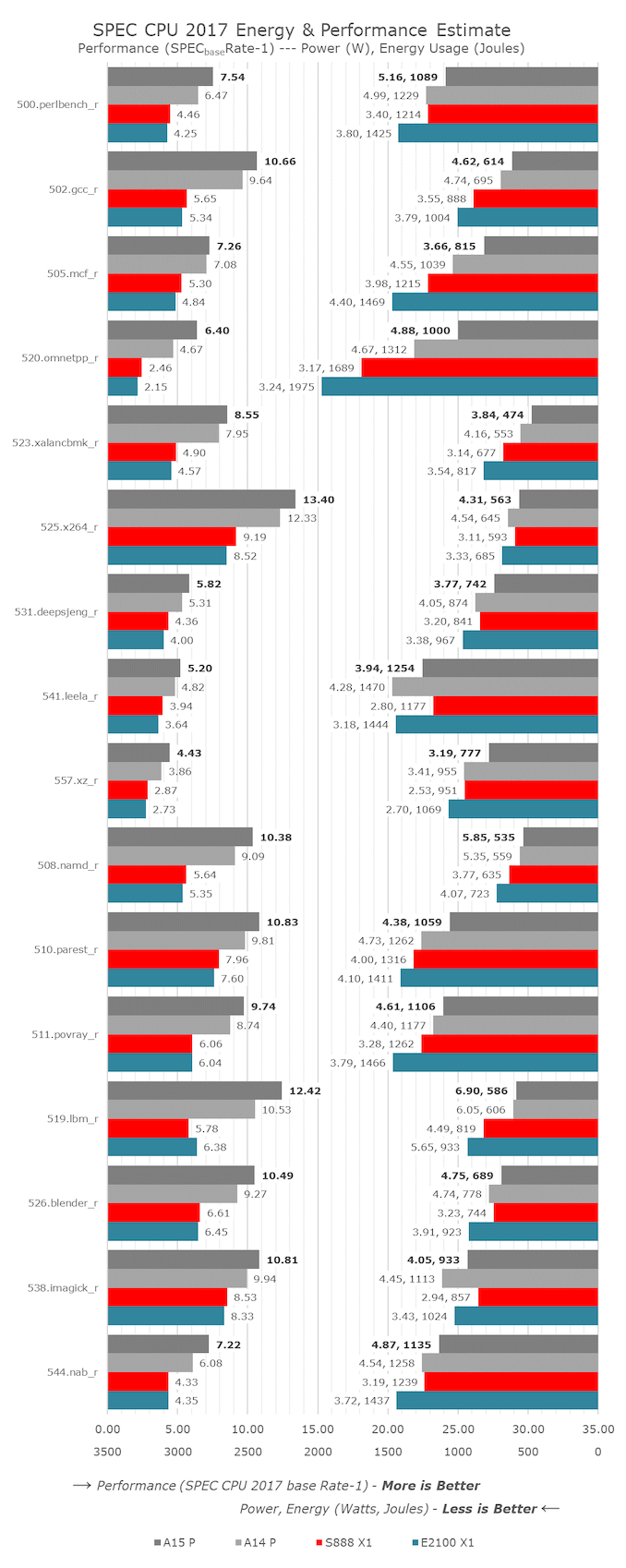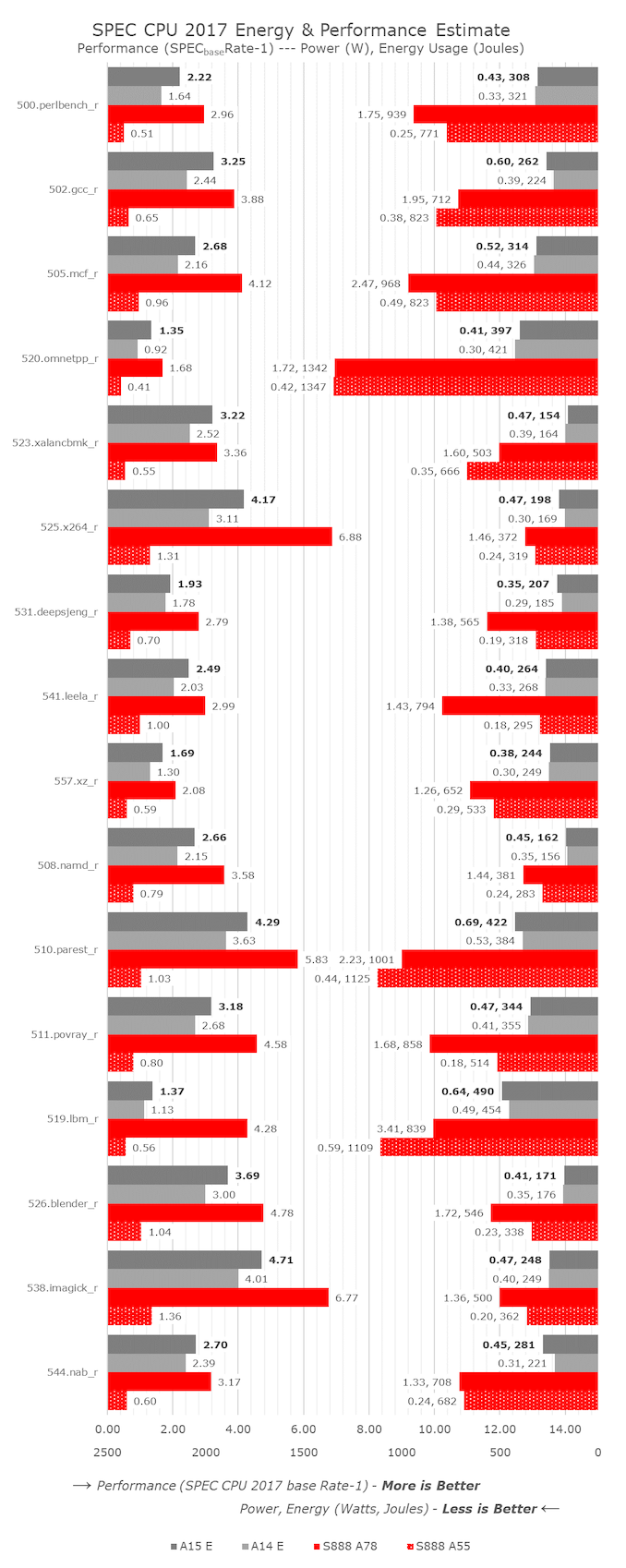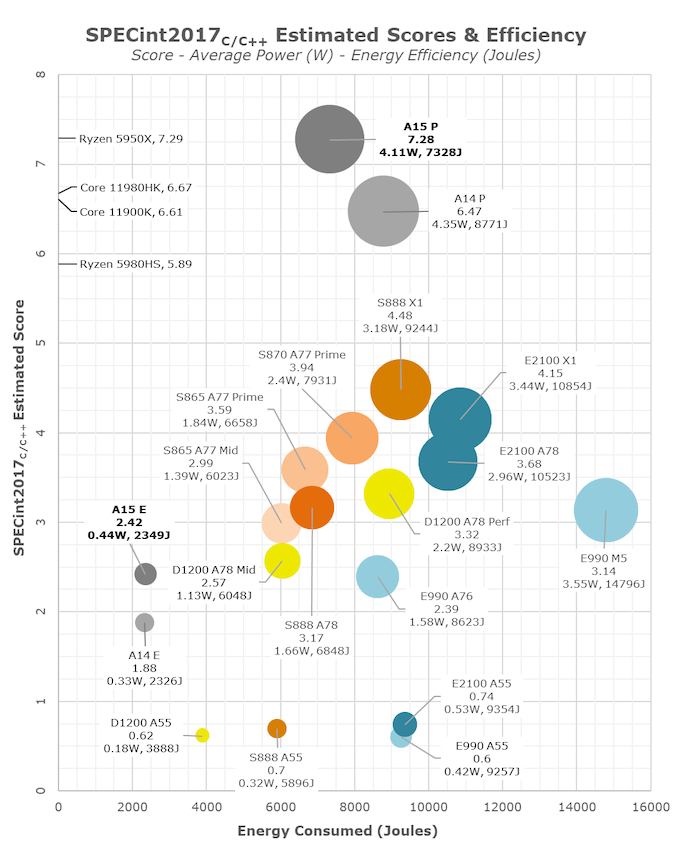The Apple A15 SoC Performance Review: Faster & More Efficient
by Andrei Frumusanu on October 4, 2021 9:30 AM EST- Posted in
- Mobile
- Apple
- Smartphones
- Apple A15
CPU ST Performance: Faster & More Efficient
Starting off with this year’s review of the A15, in order to have a deeper look at the CPU single-threaded performance and power efficiency, we’re migrating over to SPEC CPU 2017. While 2006 has served us well over the years and is still important and valid, 2017 is now better understood in terms of its microarchitectural aspects in its components, and becoming more relevant as we moved our desktop side coverage to the new suite some time ago.
One continuing issue with SPEC CPU 2017 is the Fortran subtests; due to a lacking compiler infrastructure both on iOS and Android, we’re skipping these components entirely for mobile devices. What this means also, is that the total aggregate scores presented here are not comparable to the full suite scores on other platforms, denoted by the (C/C++) subscript in the score descriptions.
As always, because we’re running completely custom harnesses and not submitting the scores officially to SPEC, we have to denote the results as “estimates”, although we have high confidence in the accuracy.
In terms of compiler settings, we’re continuing to employ simple -Ofast flags without further changes, to be able to get the best cross-platform comparisons possible. On the iOS side of things, we’re running on the newest XCode 13 build tools, while on Android we’re running the NDKr23 build tools.
In terms of performance and efficiency details, we’re swapping the graphs around a bit from now on – on the left axis we have the performance scores of the tests – larger bars here mean better performance. On the right-side axis, growing from right to left are the energy consumption figures for the platforms, the smaller the figure, the more energy efficient (less energy consumed) a workload was completed. Alongside the energy figure in Joules, we’re also showcasing the average power figure in Watts.
Starting off with the performance figures of the A15, we’re seeing increases across the board, with absolute performance going up from a low of 2.5% to a peak of +37%.
The lowest performance increases were found in 505.mcf_r, a more memory latency sensitive workload; given the increased L2 latency as well as slightly higher DRAM latency, it doesn’t come too unexpected to see a more minor performance increase. However, when looking at the power and efficiency metrics of the same workload, we see the A15 use up almost 900mW less than the A14, with energy efficiency improving by +22%. 520.omnetpp_r saw the biggest individual increase at +37% performance – power here went up a bit, but energy efficiency is also up 24%.
The smallest performance gains of the A15 are found in the most back-end execution bound workloads, 525.x264_r and 538.imagick_r improve by only 8.7%, resulting in an IPC increase of 0.6% - essentially within the realm of measurement noise. Still, even here in this worst performance case, Apple still managed to improve energy efficiency by +13%, as the new chip is using less absolute power even though clock frequencies have gone up.
The most power demanding workload, 519.lbm_r, is extremely bandwidth hungry and stresses the DRAM the most in the suite, with the A15 chip here eating a whopping 6.9W of power. Still, energy efficiency is generationally slightly improved as performance goes up by 17.9% - based on first teardown reports, the A15 is still only powered by LPDDR4X-class memory, so these improvements must be due to the chip’s new memory subsystem and new SLC.
Shifting things over to the efficiency cores, I wanted to make comparisons not only to the A14’s E-cores, but also put the Apple chips in context to the competition, a Snapdragon 888 in this context, comparing against a 2.41GHz Cortex-A78 mid-core, as well as a 1.8GHz Cortex-A55 little core.
The A15’s E-cores are extremely impressive when it comes to performance. The minimum improvement varies from +8.4 in the 531.deepsjeng_r, essentially flat up with clocks, to up to again +46% in 520.omnetpp_r, putting more evidence into some sort of large effective sparse memory access parallelism improvement for the chip. The core has a median performance improvement of +23%, resulting in a median IPC increase of +11.6%. The cores here don’t showcase the same energy efficiency improvement as the new A15’s performance cores, as energy consumption is mostly flat due to performance increases coming at a cost of power increases, which are still very much low.
Compared to the Snapdragon 888, there’s quite a stark juxtaposition. First of all, Apple’s E-cores, although not quite as powerful as a middle core on Android SoCs, is still quite respectable and does somewhat come close to at least view them in a similar performance class. The comparison against the little Cortex-A55 cores is more absurd though, as the A15’s E-core is 3.5x faster on average, yet only consuming 32% more power, so energy efficiency is 60% better. Even for the middle cores, if we possibly were to down-clock them to match the A15’s E-core’s performance, the energy efficiency is multiple factors off what Apple is achieving.
In the overview graph, I’m also changing things a bit, and moving to bubble charts to better spatially represent the performance to energy efficiency positioning, as well as the performance to power positioning. In the energy axis graphs, which I personally find to be more representative of the comparative efficiency and resulting battery life experiences of the SoCs, we see the various SoCs at their peak CPU performance states versus the total energy consumed to complete the workloads. On the power axis graphs, we see the same data, only plotted against average power. Generally, I find distinction of efficiency here to be quite harder between the various data-points, however some readers have requested this view. The bubble size corresponds to the average power of the various CPUs, we’re measuring system active power, meaning total device workload power minus idle power, to compensate components such as the display.
Apple A15 performance cores are extremely impressive here – usually increases in performance always come with some sort of deficit in efficiency, or at least flat efficiency. Apple here instead has managed to reduce power whilst increasing performance, meaning energy efficiency is improved by 17% on the peak performance states versus the A14. If we had been able to measure both SoCs at the same performance level, this efficiency advantage of the A15 would grow even larger. In our initial coverage of Apple’s announcement, we theorised that the company might possibly invested into energy efficiency rather than performance increases this year, and I’m glad to see that seemingly this is exactly what has happened, explaining some of the more conservative (at least for Apple) performance improvements.
On an adjacent note, with a score of 7.28 in the integer suite, Apple’s A15 P-core is on equal footing with AMD’s Zen3-based Ryzen 5950X with a score of 7.29, and ahead of M1 with a score of 6.66.
The A15’s efficiency cores are also massively impressive – at peak performance, efficiency is flat, but they’re also +28% faster. Again, if we would be able to compare both SoCs at the same performance level, the efficiency advantage of the A15’s E-cores would be very obvious. The much better performance of the E-cores also massively helps avoiding the P-cores, further improving energy efficiency of the SoC.
Compared to the competition, the A15 isn’t +50 faster as Apple claims, but rather +62% faster. While Apple’s larger cores are more power hungry, they’re still a lot more energy efficient. Granted, we are seeing a process node disparity in favour of Apple. The performance and efficiency of the A15 E-cores also put to shame the rest of the pack. The extremely competent performance of the 4 efficiency cores alongside the leading performance of the 2 big cores explain the significantly better multi-threaded performance than the 1+3+4 setups of the competition.
Overall, the new A15 CPUs are substantial improvements, even though that’s not immediately noticeable to some. The efficiency gains are likely key to the new vastly longer battery longevity of the iPhone 13 series phones – more on that in a dedicated piece in a few days, and in our full device review.













204 Comments
View All Comments
Zerrohero - Tuesday, October 5, 2021 - link
I don’t know but it’s still better than anything else out there?LiverpoolFC5903 - Tuesday, October 5, 2021 - link
All that power, but what is the point? Its crippled by iOS and you can only do so much on an iphone. Can you run emulators? Can you attach standard game controllers/peripherals like you can do on android? Can you copy and paste media files from your PC into your Iphone without going through a convoluted process?If this hardware was available to android phone manufacturers, you could actually see the potential of these chips.
I believe Apple can mint money by selling their SOCs to Android smartphone manufacturers. It doesnt have to be the latest one, they could offer last years SOCs at premium prices for high end android devices. Imagine running Dolphin on a A14 or A15 powered android phone!
Zerrohero - Tuesday, October 5, 2021 - link
You have never used an iPhone.So how do you know this HW is “crippled by iOS”?
Apple itself is using this power for many very nice consumer facing features, like computational photography. Faster and more efficient prosessing, yes please.
What are those amazing power user use cases that Android allows and iOS doesn’t?
Android OEMs have shown year after year that they can’t unleash the potential of anything because they don’t own any of the relevant parts (chips, SW) and they don’t understand product design.
And yes, PlayStation and Xbox controllers work just fine in iPhone and iPad.
LiverpoolFC5903 - Tuesday, October 5, 2021 - link
Do what exactly? Browse the web? Listen to music? Do social media?I can connect controllers, mice, keyboards, external hardrives, pendrives and others via USB OTG. I can install any emulator I like from any source I want and not just play store. I can download apps from anywhere, store them and send them to other phones. I can simply copy and paste my music collection in my desktop to my phone as opposed to going through a rigamarole. I can root, install custom roms of any shape and form I like. I can completely alter the way my phone looks and functions. I can install browsers like Firefox with different engines as opposed Webkit based browsers ONLY, all of which are simply clones.
I can do so much more with my phone, you cannot possibly fathom as an iphone user.
An android phone with APple SOC would be a billion times better than an IOS phone with the same hardware in terms of overall functionality.
Nozuka - Tuesday, October 5, 2021 - link
All the things you listed will feel like a waste of time to most users, tbh. ;) (And can also cause a lot of problems)I used to like these things too in the earlier android years and i get how it can be fun. but now i just can't be bothered to spend the time. I just need a reliable and fast phone that does the most important tasks well and gets updates for a long time and stays fast. The A15 will be plenty fast for years.
And if i ever get a new device, i just want to restore without any hassle. Or if a new OS version arrives, i want to install it without fear that any of the customizations will be broken.
IMHO iOS still provides the most hassle free experience. And if the masses are missing some crucial feature it usually gets added.
But if you like to tinker around, then iOS devices are definitely not the right devices for you.
" I can simply copy and paste my music collection in my desktop to my phone as opposed to going through a rigamarole. "
I would argue that this is way more tedious than just adding the music to your library once and then it is available on all your devices.
dontlistentome - Tuesday, October 5, 2021 - link
Hey Siri/Google. Show me two people with opposing use-cases. :-)I call a draw (I can be judge, I have a 13 pro and a Pixel 5. Like both).
Spunjji - Friday, October 8, 2021 - link
Your comment speaks to my own experiences. I used to be big into Android customisation in the early days, but I gave up around about Android 5 / Lollipop when the core OS included sufficient features to be satisfying. I got extremely tired of screwing around with hacking in custom software, and my experiences with the numerous things you can *theoretically* do with an Android device were - generally speaking - poor, and not worth the effort.michael2k - Wednesday, October 6, 2021 - link
6+ years of OS updates? And before you laugh, my sister in law and mother in law both rock iPhone 6S models getting iOS 15Also you seem to be under the mistaken assumption that iOS doesn't support USB drives:
https://www.amazon.com/SanDisk-iXpand-Flash-Drive-...
External keyboards:
https://www.amazon.com/Omars-Certified-Plug-n-Go-L...
USB OTG:
https://www.amazon.com/Adapter-Compatible-Portable...
You are correct that Apple hasn't unlocked a lot of the iPhone's potential; but it's also correct that no one in Android space is willing to pay the premium necessary to come close to the iPhone's processor either. There just aren't enough people like you willing to pay enough to pay Qualcomm the extra cost of developing a faster and more powerful CPU
Nicon0s - Tuesday, October 5, 2021 - link
The same tired "you have never used an iphone argument" actually showing lack of arguments.The road for computational photography was paved by Android smaprhones not Apple.
Computational photography on the Pixel 4a with the very old SD 730 is better than on an iphone SE 2020 for example.
>What are those amazing power user use cases that Android allows and iOS doesn’t?
Well it looks like you are quite unfamiliar with Android.
Anyway a simple example is Dex and similar implementations on other phones.
Another examples is being able to use emulators and turning an Android phone into a mini console.
Aq901_22 - Tuesday, October 5, 2021 - link
> Computational photography on the Pixel 4a with the very old SD 730 is better than on an iphone SE 2020 for example.A key differences is that the SE 2020 does computational photography/videography in real time, which necessitates a decently powerful professor to execute those tasks? The Pixel 4a doesn’t have Live HDR in preview/during recording when recording videos (only in stills), nor does it have real-time Portrait Mode/bokeh control simultaneously with Live HDR nor something like Portrait Lighting control before taking a pic? The point is, the Pixel 4a has impressive computational features (like night mode, which the SE lacks) for its price.
But it’s downsides is that everything is done in post (minus HDR), and the Pixel 4a is notorious for having slower processing compared to its predecessors. So while the 4a is better than the SE 2 in stills (in low light specifically), the SE 2 has much better videography due to Apple’s obsession with doing everything in real time. And this doesn’t take into factor that the SE is also better in slow-motion, panoramas, time-lapse due to using its computational features and implementing it across the board.
The 4a is great for the price and despite using a much slower processor, it has a pretty good camera. But this also makes it have disadvantages—and this is shown across the Pixel lineup, including the 5. I say this as a huge Pixel fan and owning one.